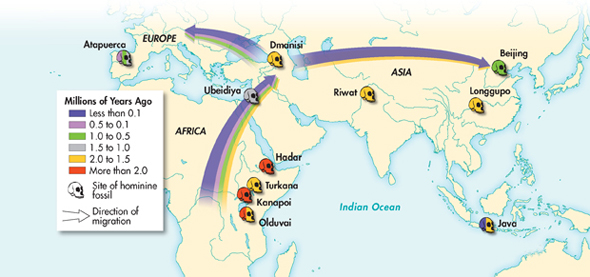▸ The First to Leave Fossil and molecular evidence suggest that some hominines left Africa long before Homo sapiens evolved. It also appears that more than one Homo species made the trip in waves. Again, researchers differ as to the identity of various fossils, but agree that hominines began migrating out of Africa at least 1.8 million years ago. Hominine remains from that period were found in the Republic of Georgia, which is north of Turkey and far from Africa. Some researchers who have examined those remains argue that they might belong to a smaller-brained Homo species, Homo habilis.
▸ Homo erectus in Asia According to some researchers, groups of Homo erectus left Africa and traveled all the way across India and through China to Southeast Asia. In fact, some of the oldest known specimens of H. erectus were uncovered on the Indonesian island of Java. This suggests that these ancient wanderers spread very rapidly once they left Africa. These H. erectus populations continued to survive and evolve across Asia for as long as 1.5 million years.
▸ The First Homo sapiens Paleontologists have long debated where and when Homo sapiens arose. One hypothesis, called the multiregional model, suggests that, in several parts of the world, modern humans evolved independently from widely separated populations of H. erectus. Another hypothesis, the “out-of-Africa” model, proposes that modern humans evolved in Africa about 200,000 years ago, migrated out of Africa through the Middle East, and replaced the descendants of earlier hominine species.
Recently, molecular biologists analyzed mitochondrial DNA from living humans around the world to determine when they last shared a common ancestor. The estimated date for that African common ancestor is between 200,000 and 150,000 years ago. More recent DNA data suggest that a small subset of those African ancestors left northeastern Africa between 65,000 and 50,000 years ago to colonize the world. These data strongly support the out-of-Africa model.
BUILD Vocabulary
MULTIPLE MEANINGS The word sapient means “wise.” It is also used as an adjective referring to Homo sapiens.

FIGURE 26–20 Out of Africa Data show that relatives and ancestors of modern humans left Africa in waves. But when—and how far did they travel? By comparing the mitochondrial DNA of living humans and by continuing to study the fossil record, scientists hope to improve our understanding of the complex history of Homo sapiens. (Note: Skulls on the map do not indicate that skulls were found at each location.)
Table of Contents
- Formulas and Equations
- Applying Formulas and Equations
- Mean, Median, and Mode
- Estimation
- Using Measurements in Calculations
- Effects of Measurement Errors
- Accuracy
- Precision
- Comparing Accuracy and Precision
- Significant Figures
- Calculating With Significant Figures
- Scientific Notation
- Calculating With Scientific Notation
- Dimensional Analysis
- Applying Dimensional Analysis




